In 1931 The Bolt, a ballet with music by Dmitri Shostakovich, was pulled from Russian theatres after just one performance. The composer knew the libretto was daft: a group of malcontents sacked from a factory plot the destruction of a new machine, communists foil the plan, then dance around said machine. But this silliness gave the creators – also numbering the experimental choreographer Fedor Lopukhov and designer Tatiana Bruni – the opportunity to make a spectacular hybrid: a classical ballet married to proletarian performance, incorporating elements of popular song. The authorities deemed its treatment of industrial sabotage too satirical. At this point Shostakovich was a prodigy in his mid 20s: it would be a few years before his opera Lady Macbeth of the Mtsensk District would really draw Stalin’s ire.
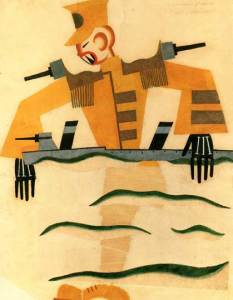
The Japanese Marine, costume design for ‘The Bolt’ (1931), Tatiana Bruni Courtesy GRAD and St Petersburg Museum of Theatre and Music
The Gallery for Russian Arts and Design has elegantly assembled the ballet’s remaining traces. In the centre of the room, surviving costumes by Bruni resemble Constructivist blocks of pure colour. Photographs from the rehearsal and design process show the production line of costumes for a ballet about production lines. A recent recording of Shostakovich’s score is played in full throughout. But the exhibition’s focal point is Bruni’s mixed-media costume designs, which line the walls. For a furnace worker’s mask, Bruni added a little square of metal gauze to her painting, making it appear like a samurai. All the designs, in fact, give the impression of a far eastern tradition of urgent, textured two-dimensionality.
The Bolt never really lived, so there is pathos to all the objects brought together here. But ‘Bolt’ is often inscrutable as well as exquisite. The black and white photographs of dancers in rehearsal are static representations of movement, reminders that you’ll never know where they were going. Only a handful of people ever did. There are two pages from a reduced piano score, annotated in pencil with small drawings of the stage, hinting at a snippet of the original choreography, all of which has been lost. Unfortunately for the modern gallery-goer, no transcription or translation of the Russian handwriting has been made available.
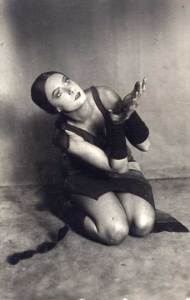
Photograph of rehearsals of ‘The Bolt’ (1931) Courtesy GRAD and St Petersburg Museum of Theatre and Music
It is not exceptional that choreography from this time is lost. A standard form of notation had yet to be developed, and filming wasn’t widespread. There is no full record, for instance, of the choreography for Stravinsky’s The Rite of Spring, which was the most famous ballet of its time. It was therefore expected that the choreographer’s vision would be as ephemeral as The Bolt itself, disappearing as soon as the dancers left the stage. But it is a shame that this fragment hasn’t been treated to some sort of decipherment, in the same way a palaeographer or philologist might treat an early form of a language.
The same goes for Bruni’s wonderful designs, which have her scrawl all over them. I was told they were most often notes about materials, but having even the most workmanlike detail would have helped pin The Bolt down. The exhibition has an accompanying app: a great move, enabling most of the context to be discreetly available without crowding the walls. But the app designer missed a trick by not transcribing all this content.
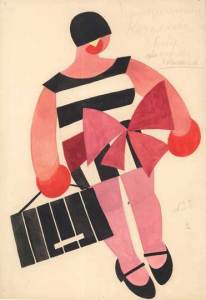
Kozelkov’s Girlfriend, costume design for ‘The Bolt’ (1931), Tatiana Bruni Courtesy GRAD and St Petersburg Museum of Theatre and Music
The gallery wall outlines for us the plot of the ballet, but again, due to the loss of some of Bruni’s drawings, the exhibition in a way changes the script. The story we are told by the available drawings is of a range of garish incidental characters, such as the pretentious factory clerk Kozelkov, who does a foxtrot for a group of his tattooed, pseudo-cosmopolitan friends. The brilliant designs for these ‘friends of Kozelkov’ take up what must be almost a quarter of the gallery’s wall space, whereas designs for the two main antagonists – Lyonka Gulba and Goshka – have not survived, although there are seven designs for the layabout ‘friends of Lyonka’ on the walls. One of these could in fact be for Lyonka, but nothing is certain. Of the five full costumes displayed one is a 2004 reconstruction, and one of the 1931 originals isn’t assigned to a character.
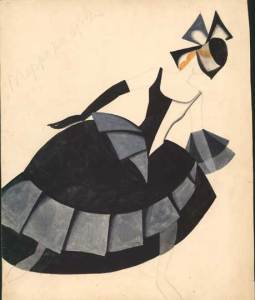
The Terrorist, costume design for ‘The Bolt’ (1931), Tatiana Bruni. Courtesy GRAD and St Petersburg Museum of Theatre and Music
The most striking of Bruni’s designs is ephemeral and beautiful just like the idea of Bolt. The Terrorist is a woman in an elaborate funereal black dress, and can be seen in the very corner of the exhibition. She is given no explanation in any of the gallery literature, and the design leaves parts of her limbs transparent, as if predicting the costume’s dissolving from history and theatre inventories. What you’re left with is the eerie sense of time’s own powers of censorship.
‘Bolt’ is at the Gallery for Russian Arts and Design (GRAD), London, until 28 February 2015.
Unlimited access from just $16 every 3 months
Subscribe to get unlimited and exclusive access to the top art stories, interviews and exhibition reviews.

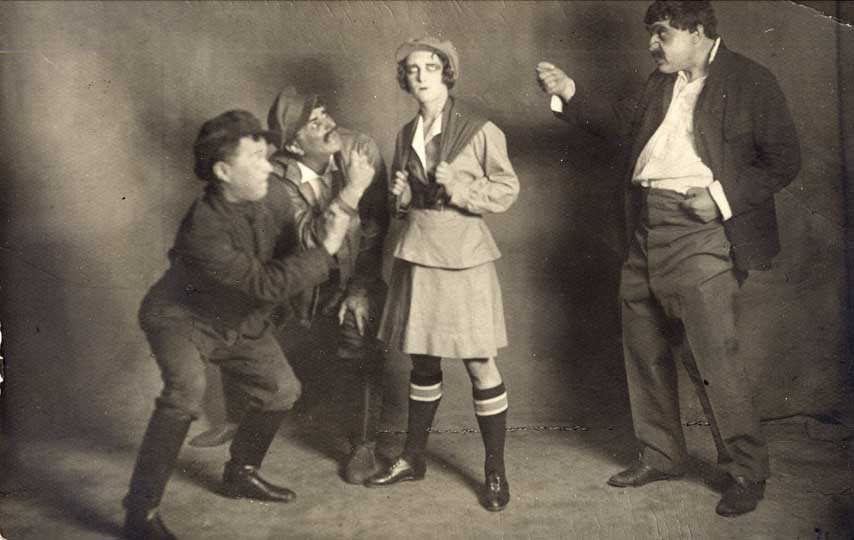

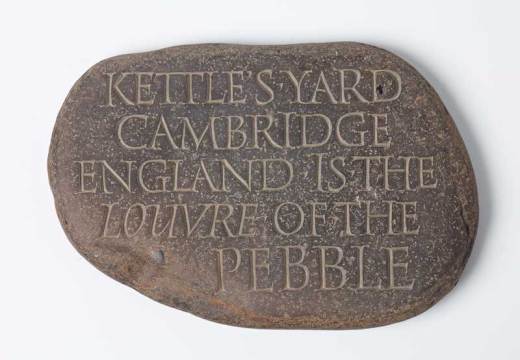
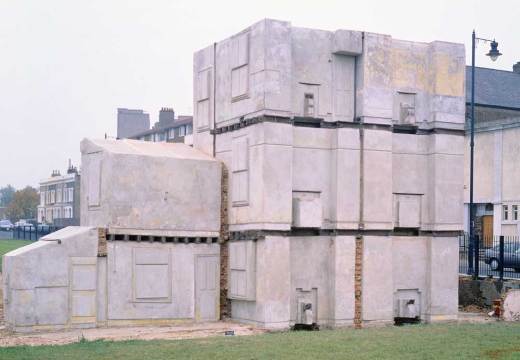









![Masterpiece [Re]discovery 2022. Photo: Ben Fisher Photography, courtesy of Masterpiece London](http://www.apollo-magazine.com/wp-content/uploads/2022/07/MPL2022_4263.jpg)
Why are fathers so absent from art history?